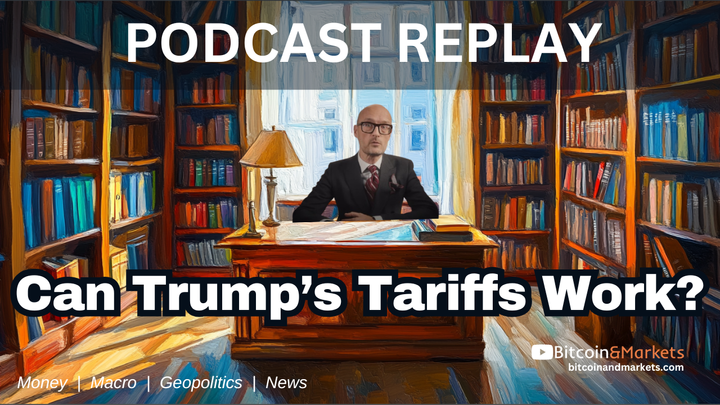Comparing BTC and ETH Inflation - E215
A discussion about bitcoin and ethereum inflation around a tweet from Ryan Sean Adams, a popular etherean.

In this episode, I base a discussion about bitcoin and ethereum inflation around a tweet from Ryan Sean Adams, a popular etherean. I touch on the bitcoin halving, the fact that bitcoin’s supply is not changing, and how ethereum wants to copy bitcoin and make unwarranted comparisons.
Tweet: https://twitter.com/RyanSAdams/status/1259877725550055431?s=20
Get The Bitcoin Dictionary!
Bitcoin jargon demystified. Over 180 Bitcoin terms, concepts, and idioms.
bitcoindictionary.cc
The TOP Free Bitcoin Newsletter!
Don't miss another issue. Subscribe to the Free tier!
Subscribe to the Pod!
iTunes | Stitcher | Google Pods | YouTube | Soundcloud | RSS
The Show Needs Your Support
We’re a small operation and producing quality content people find valuable.
Check out our big list of ways to help the show
Affiliates
- Chart Like A Pro With TRADINGVIEW
- The Best WordPress Theme I’ve Ever Used! GeneratePress
- Sign Up For Audible And Get 2 FREE Audio Books
Have Feedback? Send it our way.
**DISCLAIMER: This is not investment advice, do your own research.**
Transcript
Transcript provided by Bradley Stone
Introduction
Alright, welcome back to the show, Bitcoiners.
This is E215 of Bitcoin & Markets. If you guys haven’t subscribed, please do so now. Also the WTF Podcast – it is part of the Bitcoin Magazine stable of podcasts – I’m now co-hosting that one. So if you want to find that and subscribe there as well. The first episode that I co-hosted was released today. I’m recording this on Friday, the 22nd of May.
In this episode, we’re going to talk about a tweet that is out there from Ryan Sean Adams and try to break that down piece by piece, dispel some misconceptions in there.
But before I get into this episode, I just want to put a note upfront here. This is a listener-supported podcast/a consumer-supported podcast. If you listen to the show, you can go to patreon.com/bitcoinandmarkets and support my work for as little as $1 a month.
If you get a lot of value out of my content, then you can look at becoming a full member at $5 a month. But this brings up a big point I wrote about this Week in the fundamentals report which goes out every Friday (you can sign up for that at the website, bitcoinandmarkets.com/report).
I’ve been thinking about this a lot, in the past, we used to pay for our news. We used to pay for our information. That was with newspapers. I had a paper route growing up, and it was a quarter per day to get the newspaper and $1 on Sundays. But you paid, the consumer paid. As for advertisers, there were advertisements, of course, but they were much less of an influence on the content. That’s because the consumer paid. If we don’t do that, we’ll have a slow degradation towards low-quality content.
And that’s what we see out there in the mainstream media. It’s just degraded and degraded until it’s pretty much worthless. It’s just programming, you’re programming your brain by watching this. It’s mind-numbing. It’s what all the zombies watch. So if you find value in content, you need to go and support it. Of course, support my show, but also, there are lots of content producers out there that are doing great work from documentaries, news, podcasting, to entertainment and even independent films, because that’s how you get quality content–by supporting the quality content. And it doesn’t take that much.
So, my challenge to you (this the end of May), I’m going to be doing this in the whole month of June, is a challenge to go and support $5 a month and spread it across wherever you think deserves it on the internet for content, whether that’s this show or other podcasts in the Bitcoin space.
Whatever you do, whatever kind of content you consume, if you want to make a donation somewhere for $5 that’s what I am promoting here. Support Quality, Get Quality. That is the June call for quality content.
The Bitcoin and Ethereum Supply Tweet
Alright, enough of that. Let’s go on to this Ethereum tweet and the stuff involved. Okay, let’s take a look at this Ryan Sean Adams tweet. He’s an “Etherean” or Ethereum dude. The Etherean label is a response to “Bitcoin maximalist” or “Bitcoiner”, proudly worn by these Ethereans, so they won’t mind that. But some of this stuff might offend some Ethereans. You know, I believe in open debate. If he’s gonna put his ideas out there, then he should be open to getting them critiqued. You need to have thick skin when you step into the public debate arena.
So, his tweet is from around the Halving stuff. I’m still catching up on some of this content. I’ve actually tried to record this episode previously, but it didn’t turn out well. So, I’m going back and trying to do it again. But he said this:
“Bitcoiners think reduced supply leads to increased demand.
Ethereans think increased demand leads to reduced supply.
BTC and ETH are the two most important monetary experiments of our time.”
Supply Function hasn’t changed
Okay, this is wrong on many, many levels. I’m going to, kind of, break it down by sentence here, because he has a split-up, so I’m going to split my stuff up here too. First, Bitcoin’s supply isn’t being reduced. When he says that Bitcoiners think reduced supply leads to increased demand, Bitcoin’s supply is not being reduced. It hasn’t changed. Even this Halving doesn’t change the supply, 21 million. It was 21 million at the Genesis block, it’s still 21 million.
The issuance hasn’t even changed. The issuance algorithm was Halving every… What is it? 210,000 blocks. That started the Genesis block, and it’s still continuing the same as always. I mean, you could stretch it and say that the actual absolute issuance from 12.5 to 6.25, every block has changed. But that’s missing the broader point. First off, the total supply is not changing. And that’s the meat of this argument. So, everything is the same after the Halving as it was before the Halving, nothing changed.
The use of this word “reduced” implies that it was changed, but it wasn’t. He has to do that, because Ethereum changes its supply and inflation rate willy-nilly. Bitcoin does not. Bitcoin does not have inflation in a technical sense, because the supply is 21 million. The issuance changes by design, the design has not changed, but the issuance changes, but Ethereum changes that inflation all the time.
So, he has to compare these two, he has to use this word “reduced” to compare Ethereum versus Bitcoin, when there really is no comparison. He has to use a straw man, he could have easily said it differently. He could have explained it with a few more words. I mean, he used nice prose here, in his tweet, but he missed (on purpose, I believe) a lot of nuances. Very important nuance, critical nuance. Bitcoin does not get its value from reducing its supply. It gets its value from a fixed supply that goes along with fixed consensus rules, the supply is the same, the consensus rules are the same, nothing changed. Okay, that’s where Bitcoin gets its value from: from not changing.
Social Contract in Bitcoin
But of course, I can hear all the Ethereans saying “But the social contract, bro! Everything is subordinate to the social contract. If 100% wanted to change the Bitcoin rules, the Bitcoin rules would change!”
It is not a social contract. There is no social contract that controls the consensus rules of Bitcoin. Subordinating the distributed consensus – which is primary in Bitcoin – to a social consensus, that undermines or defeats the whole purpose of the distributed consensus in the first place! A distributed consensus is to make it (the network) independent of anything else. It is not dependent on anything else. It is supreme and primary. If you subordinate it to some other thing, then what the hell is a distributed consensus for in the first place?!
In Bitcoin, social consensus is subordinate to the distributed consensus. That’s why soft forks can happen, because it’s within the consensus rules. This is the only way that it makes sense to even have a distributed consensus in the first place. Of course, Ethereum’s distributed consensus is subordinate to a social consensus, and that’s the projection he’s doing here. Again, he’s trying to compare and shoehorn Bitcoin into this theory or model, which doesn’t work. Ethereum is controlled by social consensus, and that’s bad.
I was on the POV Crypto podcast with Christian and David. This was probably two or three months ago now. I think it was their hundredth episode, a big celebration that they were doing and they had a bunch of people on. But I went on there, and I was like “hard forks are really a Byzantine attack.” And it’s coming back to that now because it’s true. If you,… well, let’s talk about what a Byzantine attack is first, because some people might not know.
So, this is a computer science idea, called the “Two Generals Problem,” and it goes like this:
You have two generals on opposite sides of a city. They’re sieging the city. They need to attack, and they need to agree on the time of the attack or retreat. If they both attack, they will take the city. If one attacks it will be defeated and utterly destroyed. But the problem here is you can’t trust the messengers. So, the messenger might change the message. One general sends a message to the other side of the city to attack at dawn. But that messenger changes it to attack at noon or attack at one hour prior to dawn, whatever, and they get destroyed.
You can’t trust the messenger. You also can’t trust the other general either because maybe there’s some internal conflict within the Byzantine Empire and there’s some general A who wants to get rid of general B. And so he’s going to send a faulty message about when to attack because he wants to get rid of the other person.
So you can’t trust the messenger, the message, or the other general. So how do you move forward? How do you come to a conclusion? And this theory says you can’t. A distributed network cannot come to a reliable consensus.
There were a few things before Bitcoin that led to the ability to form this distributed consensus, but there was no permissionless entry and exit. All nodes had to know about all other nodes. And there’s no way to make this a truly open and permissionless system, until Bitcoin came around with proof of work. The idea of a social consensus being primary over a distributed consensus, totally turns this Byzantine fault tolerance on its head.
A hard fork is a Byzantine failure! Especially in this case. If the nodes cannot come to a consensus, according to the old rules (the current rules prior to the fork), and they have to change to new rules, that change is outside of the consensus, right? So you’re stopping consensus. There’s a consensus failure. And if the social contract is causing that, then the social contract is a Byzantine attack on the distributed consensus. It (the distributed consensus) must be above and beyond any social influence or else it is not Byzantine fault-tolerant.
Inflation in Ethereum
Okay. Let’s move on to the next sentence. Only one sentence into this tweet, LOL.
Ethereans think increased demand leads to reduced supply. How is that possible? That’s contradicted by all ideas of supply and demand. You know, just taking this back to a basic economics standpoint. When demand goes up relative to supply, the price will go up. And as price goes up, margins go up, and profitability to produce that good goes up. And so production goes up.
Of course, regulation can short-circuit this, but that is the way that supply and demand are supposed to work. Not demand going up causing a reduction in supply. That’s totally backward.
Now, there are a few different things that they could be meaning here. That would be like Gresham’s law, which says that good money will go into hordes, while the bad money is circulated. And this is if they have an equal face value. So there’s some little caveats to Gresham’s law. But that could be it, that the demand is going up for Ethereum and so somehow that makes more supply go into hordes, which are going to staking or whatever. That’s a little bit of a stretch.
They could be saying the new upgrade, I think the number is 1559, and it has to do with burning a fraction of all the fees. So, as more transactions happen on Ethereum, there will be more burning. I mean, there’s a lot of things wrong with that idea. Just for starters here to suffice, that it dis-incentivizes transactions. And if you’re in proof-of-stake, you have no distribution mechanism. So, you have fewer transactions, less distribution by mining, and so it will grind to a halt, there will be no velocity. So there’s a lot of problems there.
I mean, as you can see Ethereum is just jumbling all these ideas together and saying it’s going to somehow work out to minimum viable issuance. Well, what if the minimum viable issuance is higher? I think that the minimum viable issuance for Ethereum is high single digits. That’s enough to stimulate the economy and to provide subsidies around the space to bring in developers and marketing firms, and all sorts of things. It’s just like, the minimum viable issuance, say, for Ripple. Now I know that ripple is 100% pre-mine, but they unlock a certain amount, I think it’s a billion a month, right, a billion Ripples a month, and they can use that to subsidize their development and to subsidize marketing and all this stuff. So ripple might be more successful, if they spent more money on the marketing side. The same goes for Ethereum. If they spent more money, handing out more money, more grants from the Ethereum Foundation, and Consensys – I mean, that is their whole business model over at Consensys is to provide subsidies to the entire Ethereum ecosystem.
I believe Ethereum would benefit from higher inflation. If you look at the chart, and then you look at the issuance throughout Ethereum’s history, what happened shortly after they decreased from… I think it was five Ethereum per block down to three, well, they hit their all-time high. It’s been downhill from there, and they keep cutting their issuance thinking, “Oh, we need to copy Bitcoin and have harder money and less inflation.”
Well, that’s true. They’re in competition on a monetary front with Bitcoin, but it’s not going to respond the same, because there is no set rule for inflation. So, they’re in this catch-22. If they decrease their inflation, that slows the economy down. And if they increase their inflation, then they’re in competition with a less inflationary good being Bitcoin, and they’re in the back seat. So it’s a no-win situation in that respect.
Bitcoin and Ethereum as Experiments
But taking this back, we’ll wrap this up here. So it is true that Bitcoin is the most important monetary experiment of our time. Minimum viable issuance with Ethereum, we don’t know what that is. We don’t know what that experiment is. It’s like having an experiment with no design.
They spent no time building the design of the experiment beforehand. So, Ethereum is not a scientific experiment. It’s a fly-by-the-seat-of-your-frickin-pants thing. Bitcoin is an experiment. It has a design. That’s science. So anyway, there is no real comparison here.
Thanks, guys. Don’t forget, this is a listener-supported podcast patreon.com/bitcoinandmarkets, you can sign up at my website bitcoinandmarkets.com/report to get the free newsletter, and I also have a members newsletter that goes out through Patreon, too. So check out that tier when you’re over there. And that’s it, guys. We’ll see you next time.




